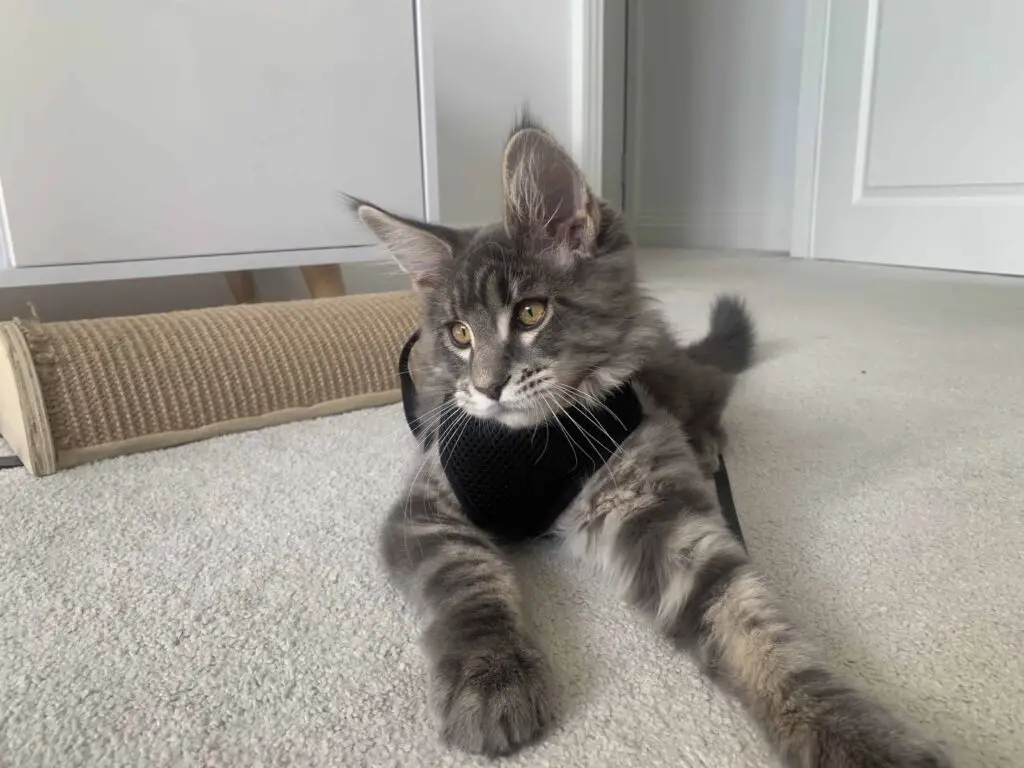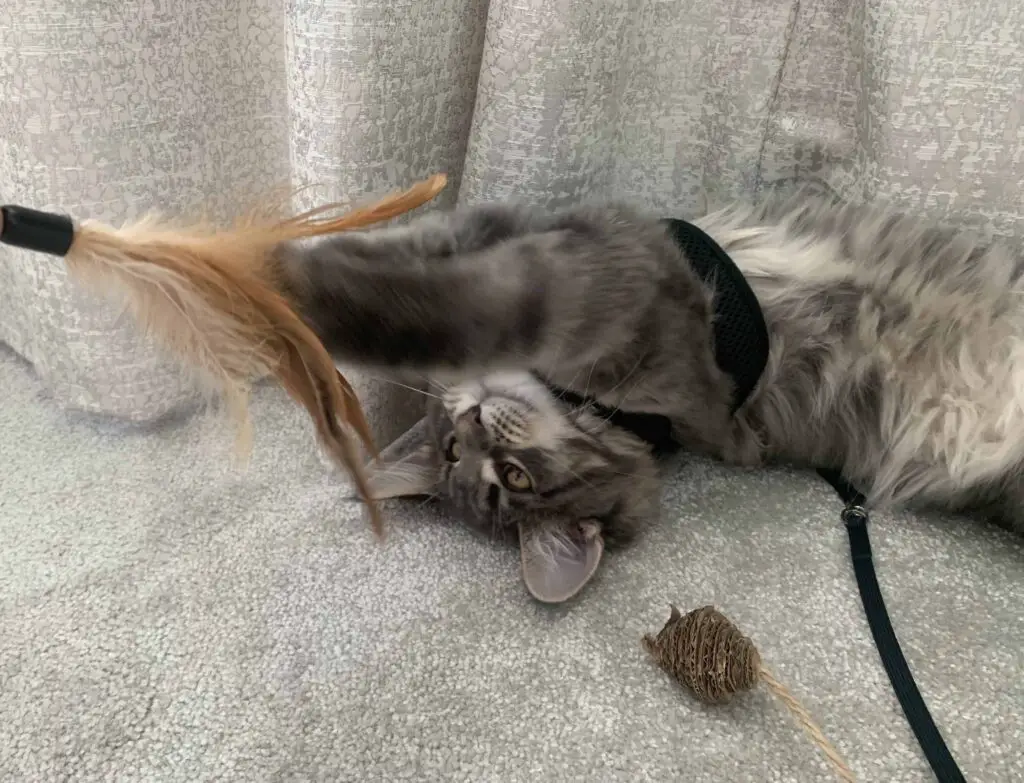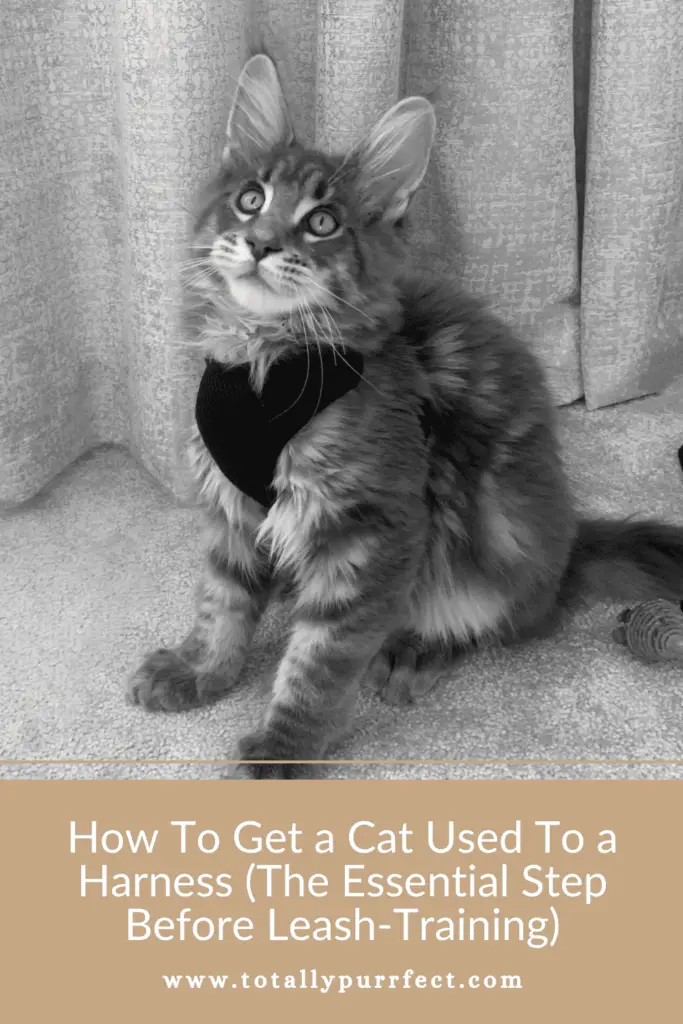So, you’re looking to train your cat or kitten to walk on a leash, but are feeling like it’s a pretty daunting task. Want to take a step back? To start with how to get a cat used to a harness? Good thinking, and good news – as in this post, we’re going to break down that all-important step before, so that you start by successfully training your cat to wear a harness. After all, there’s no point trying to run before you can walk, as they say!
Disclaimer: An Amazon Associate, I earn from qualifying purchases. There may be affiliate links within the post.
Why It’s Good To Get a Cat Used To a Harness
Getting a cat used to a harness is a smart move and makes your life far easier when it then comes to leash training.
See, trust is a big thing for cats. So if they’re unfamiliar with their harness and don’t feel safe in it – all they will focus on is trying to get out. This means you’ll then have no chance getting them to happily walk with it on!
For this reason, getting a cat used to a harness really is fundamental. It’s all about baby-steps!
Types of Cat Harnesses
So before we look at how to get a cat used to a harness, you first want to decide which cat harness you want to use and make sure you get the “right stuff!” See, there’s three main cat harness styles on the market to choose from. You’ve got:
The H-Harness:
H Harnesses connect at the cat’s neck (like a collar) and then along their back. This evenly distribute pressure and makes them more secure. They’re great if your cat is already used to wearing a collar, and are easy to put on, as it simply all clips in.
The Vest Harness:
Vest harnesses are typically made of a thicker, mesh material and are a little bigger and sturdier.
They cover more surface area of your cats body, are harder to slip out of (as long as you have the right size) and are generally more secure.
They work great if your cat pulls or wriggles. It also gives you more peace of mind as it feels more escape-proof.
The Jacket Harness:
Jacket harnesses work and look very similar to vest harnesses. The difference is, they’re bigger and your cat will usually step into it, then you velcro and clip it up.
This is far easier to get it on them, and less stressful than pushing it through their head. However, just bear in mind that some cats don’t like the sound of velcro!
Also, some jacket harnesses may also be called vest harnesses so you don’t need to be boxed in by a set name! The most important thing is that you find the right type of cat harness – with all the features you want, in place.

Picking The Right Harness
It’s worth taking the time to pick the right cat harness. After all, the wiser you choose, the easier it will be to get your cat used to it. So weigh up:
- What are they like, and which harness are they most likely to be comfortable with?
- Are there any elements they wouldn’t like? (E.G. If they don’t like the sound of velcro, I’d certainly avoid the jacket harness. Or if they’re a wriggler, you may struggle trying to get one on over their head. This means you would therefore be more suited to a step-in harness.)
- What’s their nature like? Which are they most likely to be the safest in?
- Which will provide the right balance between being safe & secure, but not too restrictive or uncomfortable?
You then want to look at the reviews.
Without being biased, Amazon is always good for buying cat essentials! You get to see full comprehensive reviews, as opposed to going in “blind” if you just pop into a pet store and want to grab one there.
They also have fast, free delivery and free returns if you’re not happy with it for any reason. This again, makes it far easier!) It’s why I get all of Cody’s things from there.
How To Get a Cat Used To a Harness
So once you’ve picked your harness and are all set, ready to go – what do you have to do if you want to get a cat used to a it? Well actually, it’s pretty simple and can work faster than you think!
We had our little Maine Coon Kitten, Cody used to a harness (enough to then happily sit and sleep in it for hours!), after just a couple of tries.
Of course, every cat is different, but that’s why I don’t think you need a set structure as such. Instead, it’s more about doing the following steps, and continuing to do them, until finally you’ve mastered cat harness training!
Here, watch this video. The steps are as followed 👇
1) Put It On Little & Often
So first up, when it comes to how to get a cat used to a harness (or how to get a kitten used to a harness, for that matter, too!), the #1 fundamental rule is: little and often, little and often.
You want them to ease into it, and feel comfortable with it. This means, putting it on them for short bursts initially; with every time it – in theory – becoming that little bit easier!
2) Stay Calm
The last thing you want to do is get worked up, stressed up, or panicky. Especially if you’re doing so because your cat / kitten is reacting to the harness… It will only make the situation worse, and stress your cat / kitten out more!
So instead, remain calm. Speak gently and soothingly to your kitten. Like, “Here we go. This is nice and easy isn’t it? There’s nothing to worry about here!”
Cats pick up on your emotions. So if you’re happy, friendly and open to the harness, and you’ve built trust with your cat, between the two of you, they’re more likely to trust that too.
3) Use Treats For Positive Associations
Treats are going to be your secret little weapon, for any type of cat training. So, what you want to do to get your cat used to a harness, is give them treats whenever they’re wearing it.
So you may give them when:
- You first put the harness on them.
- After they’ve tried to get the harness off, but have kept it on, and started playing with a toy or just simply sitting nicely with it still on them. (This shows you’re happy with their new behaviour and happy with them wearing it!)
- Before you take it off at the end.
Treats work… well… a treat, for getting a cat used to a harness. After all, they’re then being rewarded for wearing their harness and so will associate positive things to wearing it.
If you’ve made one of our DIY Cat Treat Toys, it’s also a great idea to bring this out during harness training. Especially if you already know they like to play with it!
4) Keep Them Occupied Whilst It’s On
A huge, huge, thing that helps when it comes to getting a cat used to a harness, is keeping them occupied whilst its on.
Play with them – especially if you notice them biting or scratching at their harness. Take their mind off the fact that they have it on, by focusing on something else instead. There’s heaps of different games to play with your cat to distract them.
By doing this, they start to realise that – actually – it’s no bother, really. And so they become far more comfortable with it.

5) Leave It Lying Around (Supervised)
When you haven’t got the harness on your cat or kitten, leave it lying around. Attach it safely to their cat tree, or pop it on the floor. Of course you want to only do so if they can’t get twisted within it, or when you can keep an eye on them.
But by having it around, and them getting to know it, and able to put their smell on it, they become far more familiar and accepting of the harness, even when / before it’s on them. So this is a super nice, simple trick. On a similar note…
6) Pick Your Timing Wisely
Another crafty little trick is to pick your timing wisely when putting the harness on your cat / kitten.
If they’re already in manic, wild, playing mood – it won’t be the best time. (E.G. Have they got the “zoomies?!” Then don’t even bother!) It’ll be too difficult to get it on them and they’ll be more likely to fight it, as they just want to PLAY!
Instead, the best time to put a harness on your cat / kitten when harness training, is when they’ve not long woken up. Of course you want to make sure they’re not still half-asleep. But if they’re awake again and are just about to get going – pop it on them!
7) And Stick With It!
Last but not least, the 7th final step and core essential to getting a cat used to a harness – is to be patient. Don’t rush it. But stick with it! (As no matter how old or stubborn they are, eventually – they will start to accept it!)
Remember – you should never force them your cat / kitten to wear their harness for a sustained period of time if they don’t like it or aren’t yet ready or comfortable with it.
Instead, see how well your cat / kitten is taking to it. And do everything you can to make it easier – then stick with it.
Gradually increase the amount of time they spend in the harness each time. If they look like they’re getting uncomfortable with it – take it off. If they seem happy – keep it on. Then keep going from there.
How To Get a Kitten Used To a Harness
If you’re looking to get a kitten used to a harness, the steps for how to get a cat used to a harness, still apply. The process is exactly the same. You just want to wait until they’re at least 12 weeks old to start harness and leash training.
By starting them young however, you’re actually more likely to get them used to it… Faster and easier too! This is because they’re still learning, growing and finding out what their “norm” is, so you should have more joy with it!
Once you do, and can then move on to leash training – it opens up a whole new, beautiful and exciting world for your furry little friend. Here, watch our Cody’s first time exploring outdoors. (Heart-melting or what?!) So don’t give up on it!
How To Get a Cat Used To a Harness
So there we have it – how to get a cat used to a harness, or (if they’re still in their youth!) how to get a kitten used to a harness.
The great thing is, once you’re able to train a cat to wear a harness, you can ultimately get to the place where you can take your cat for a walk, which is amazing – for both you and your cat!
It gives them that all-important exercise, enrichment and prevents boredom. It’s therefore well worth doing, and doing right – just one step at a time!
Thanks for reading! For the next steps, be sure to SUBSCRIBE.

